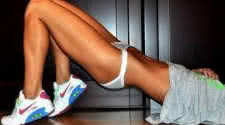Bodybuilding Through Research & Science - Hamstring Training EMG Study

A Scientific View at the Sport of Bodybuilding is Encouraging
Every strength coach knows a secret that he has yet to share with you: Any type of training that stimulates neural-muscular
integration and blood flow to your muscles by an overload (i.e., weight-bearing exercise) will result in an adaptation by
the muscle. The muscle responds to stress by getting either stronger, bigger or both. As long as you stimulate a muscle, it
will continually adapt to the stress. The stress response has been well described by the genius Hans Selye. The trick is to
never let your muscles get stagnant. Knowing how to train is important. In fact, with many contemporary exercise
physiologists the thrust of research is moving into evaluating specific exercises that may be more effective at obtaining
the results we desire.
In a study presented at the 47th annual conference of the American College of Sports Medicine (May 31-June 3,2000 in
Indianapolis), Melissa Swain MS, CES and colleagues evaluated two exercises designed to spur the hamstring muscles to get
stronger or more muscular. Most people unfortunately avoid training the hamstrings, choosing instead to focus on their
quadriceps. The problem with avoiding the hamstrings in a strength-training program is that this neglect may lead to a disparity
in strength between the quads and hams which becomes a principal factor causing knee derangements. Problems such as
osteoarthritis are more common in women than men. Scientists speculate this situation is due to an imbalance in muscular
strength.
The purpose of the hamstring study was to determine which exercise (Romanian deadlift or leg curl) activates deeper muscle
fibers in athletic adults. The researchers used technology known as an electromyograph (EMG), which can detect the electric
current in a muscle, an indication of how many muscle fibers are being activated to make a muscle contract. This technology
has many uses, and the application in exercise physiology can aid in ascertaining the best movements for obtaining maximal
results. The researchers had the athletes do both Romanian deadlifts (RD) and leg curls (LG) while taking EMG readings at two
sites (posterior and lateral aspects of the biceps femoris). By placing the EMG at both the back and side of the thigh they
obtained the rate and depth of the muscle contraction at the superficial- and deep-fiber level, respectively.
Activation of muscle fiber is measured in milli volts as it is an electric charge. The results of the study indicate that
incorporating Romanian deadlifts into your training leads to greater activation of deep muscle fibers in the biceps femoris.
Of the two exercises the RD activated almost double the number of muscle fibers (46.73 mV vs. 24.98 mV). Researchers observed
the increased muscle fiber recruitment and activation during the concentric (flexing) aspect of the lift.
This study clearly has implications for athletes involved in both strength and weight training. Activation of deeper muscle
fibers and recruitment of more motor units during an exercise may translate into better strength and size development of a
muscle. The deeper muscle soreness experienced after doing deadlifts may be due to the greater number of muscle fibers activated
in the exercise. Thus, this is one exercise where the level of soreness you feel seems to indicate how well you performed the
exercise. In the case of this study, the RD appears to be the superior movement for increasing muscular growth and strength of
the hamstrings.